
- The most common coronavirus variant in the US infects kids more than the original virus.
- But the variant, first found in the UK, is no more infectious or deadly in kids than in adults, experts told Insider.
- This is despite anecdotal reports that, proportionally, more kids are showing up to hospital.
- See more stories on Insider's business page.
The most common coronavirus variant in the US is estimated to be twice as infectious as the original, and can spread quickly amongst children. Anecdotal reports suggest young people are increasingly filling up US hospitals – but experts tell Insider that the variant, called B.1.1.7, isn't affecting kids any worse than adults.
The variant became the most common strain of the virus in the US on April 7. In Michigan, the state with the most B.1.1.7 cases, hospitalization rates were higher for kids in recent weeks, "therefore they must be sicker," Rudolph Valentini, chief medical officer for Children's Hospital of Michigan in Detroit, told Bloomberg on Monday.
"Until now we haven't seen transmission like this in kids in the pandemic," Michael Osterholm, an infectious-disease specialist at the University of Minnesota and former advisor to President Joe Biden, told Meet the Press early April. "This B.1.1.7 variant infects kids very readily," he said.
Higher numbers of kids in hospital doesn't necessarily mean the variant affects kids differently. Younger people, especially those under 16, are the least likely to be vaccinated. So while many adults are protected from COVID-19, including the variant, kids aren't, and some are ending up in hospital.
And many experts – including from the UK, where the variant was first detected in December – aren't convinced it is more infectious for children than adults, and say the variant doesn't appear to make kids sicker, either.
No evidence variant is not more infectious in kids than adults: Experts
There's no evidence that B.1.1.7, the name of the variant, is more infectious in children than adults, Damian Roland, honorary associate professor in pediatric emergency medicine at the University of Leicester, told Insider.
"Denmark has kept schools open for young kids (even without masks) and hasn't exploded," Dr. Alasdair Munroe, clinical research fellow in pediatric infectious diseases at University Hospital Southampton, said on Twitter March 11.
In Denmark, where there are high numbers of B.1.1.7, those under 20 years old were least likely to transmit the virus to others in the household, and those younger than 10 were less likely to catch it than young adults aged 25 to 45, according to a pre-print study from the University of Copenhagen posted March 5.
Read more: Just 3 governors haven't gotten their COVID-19 vaccine, Insider found. Here's who - and why.
Paul Offit, professor of pediatrics at the Children's Hospital of Philadelphia, who has served on infectious disease advisory panels for the Centers for Disease Control and Prevention (CDC), told CNBC that kids were getting infected more frequently because of how contagious the virus is, not because the variant poses a particular risk to them.
Roland told Insider that "it's not the variant, cases rise when you've got a lot of coronavirus around."
A spokesperson for The Royal College of Pediatrics & Child Health (RCPCH) told Insider that "cases in children continue to reflect cases in adults generally." They said that the best way to protect the children is to maintain "low community infection rates."
B.1.1.7 appears no more harmful to kids
Dr. Stephen Schrantz, an infectious disease expert at University of Chicago Medicine, told CNBC that young people, especially school-aged children, didn't tend to get sick because their immune systems react less severely to the virus."
Roland told Insider that kids "very rarely" get sick with COVID-19. "Often it's children presenting with non-COVID illness and then happen to have it."
About one-third of kids testing positive with COVID-19 in a London hospital during the second wave of the virus in the UK - when 70% of the capital's coronavirus infections were caused by B.1.1.7 - were admitted for another illness, according to correspondence published in the Lancet Child & Adolescent Health medical journal in February.
A London-based study published in the same journal around the same time found that severe illness and death from COVID-19 in children was rare, accounting for just under 0.2% of all UK deaths in 10 to 19 year olds, and just under 2% for those under 9. More kids died from COVID-19 when there were lots of infections in the wider community, the study authors said.

FREDERIC J. BROWN/AFP via Getty Images
Some children who contracted coronavirus have experienced Multisystem Inflammatory Syndrome in Children (MIS-C), a rare condition that can sometimes cause severe illness or death.
It doesn't appear that the B.1.1.7 coronavirus variant increases the likelihood of developing MIS-C.
Dr Liz Whittaker, consultant pediatrician at St Mary's Hospital in London, said in a statement January, when London had high levels of B.1.1.7 cases, that there were lots of children with positive COVID-19 tests, but "only small numbers" with severe disease or MIS-C, and these were within expected levels given the high infection rate at the time.
The number of children hospitalized, admitted to intensive care, or dying from COVID-19 hasn't changed on a national level following the emergence of the B.1.1.7 variant in the UK, the RCPCH spokesperson said.
In Michigan, those aged 20 to 29 and 30 to 39 years-old are most likely to be infected with coronavirus, according to state data. But while hospital admissions are going up in all age groups by 25% each week, the highest rate remains those 50 to 59 and 60 to 69 - not younger people.
